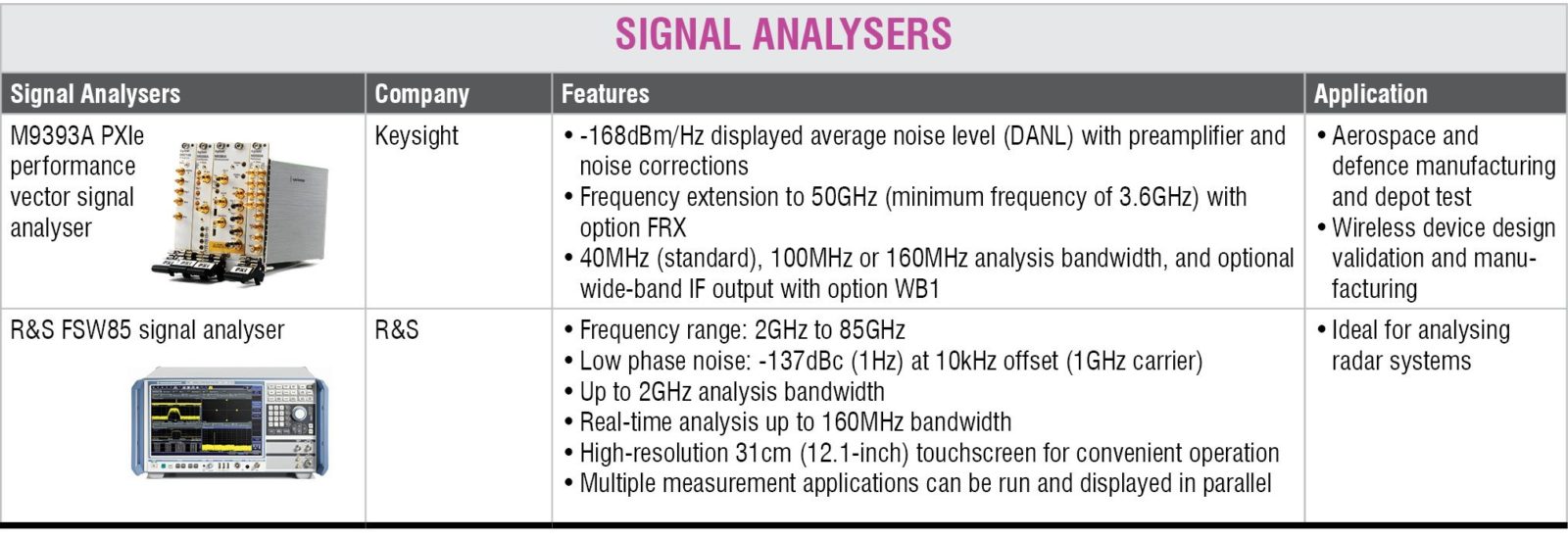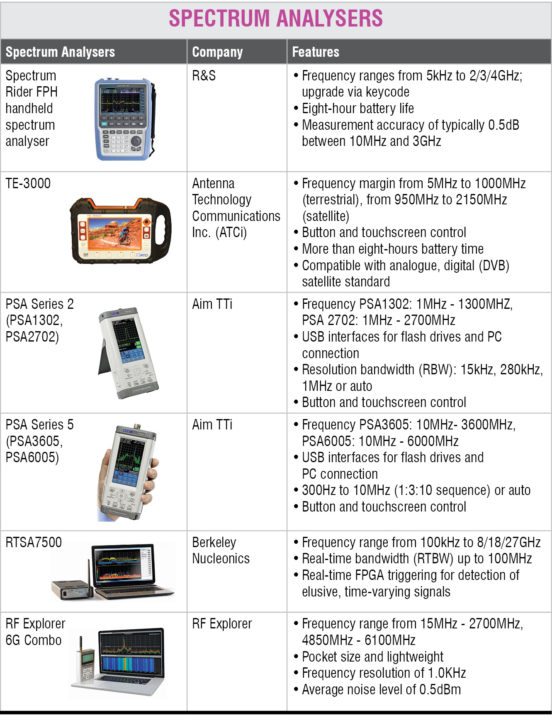While incremental specification enhancements are taken as a given in any field driven by technology, the past year has seen some interesting advances on the side of improving test and measurement (T&M) productivity. We have seen support being integrated into the equipment for some of the newer standards, better automation features as well as a renewed focus on making T&M a much better experience for the engineer. This article takes a look at the trends for the latest line of signal and spectrum analysers.
Significant improvements in bandwidth and frequency
We are seeing some significant increments in specification enhancements. “Recently, spectrum analyser lines of equipment have improved their capabilities by moving forward from featuring frequency coverage of around 20GHz to enter the millimetre range of up to 50GHz. Thus their frequency range has been enhanced quite a bit,” explains Vishal Gupta, senior applications specialist (RF/MW), Keysight Technologies. The modular PCI eXtensions for Instrumentation (PXi) form factor now features up to 26.5GHz of coverage, too.
Newer equipment come with higher analysis bandwidth. The UXA branded line from Keysight can handle up to 510MHz of real-time analysis bandwidth. This is a significant increase as the best bandwidth topped at 160MHz in 2014, adds Gupta.
“Using analysers for frequencies above 6.0GHz is a big challenge for designers. The most exciting feature/function of the spectrum analyser is to make the single-side-band noise phase to be 100dBc/Hz at offset up to 10Hz, which is rather hard to achieve,” explains Chandmal Goliya, director, Kusam Electrical Industries Ltd.

Equipment like Spectran V5 real-time spectrum analysers (RTSAs) from Aaronia AG allow continuous analysis and even real-time data streaming (for example, USB to hard disk).
“This allows all data of a desired high-frequency band to be recorded without any blind spot (for example, complete data traffic of a mobile phone tower). Real-time bandwidth can reach up to 200MHz (existing systems can reach only up to 110MHz). An ultra-fast direct-digital-synthesis sweep in S-area is possible even with 10GHz bandwidth,” explains Naveen Sharma, technical manager, Scientific Mes-Technik Pvt Ltd.
Size reduction still a focus area
For some time now, there has been an emphasis on size reduction, which has continued to the point that we now have handheld instruments, explains Gupta.
Goliya reiterates, “We think the handheld spectrum analyser is a good application for the market that values portable and lightweight equipment for outdoor use and constantly changing workplace requirements.”
Satish Thakare, chief technology officer, Scientech Technologies Pvt Ltd, feels that, “Traditional spectrum analyser instruments available in the handheld and bench-top form factors are still popular, but modular instruments are finding wider acceptance in the market due to cost, flexibility and scalability advantages.”
Three clicks or less
Rufus Danesh, project engineer at Analog Arts, says, “What makes modern signal analysers much more exciting than the previous generation is their easy integration within a framework of a computer. Most new instruments are supported by powerful application software, which can run on various operating systems. In a sense, this feature enables the instruments to form an analysis network that can be controlled from a central post.”

 We are now quite rooted in the era of touchscreens for test equipment, with newer equipment coming with touchscreens as big as 36 centimetres. These screens have also enabled an era of user interface (UI) improvements.
We are now quite rooted in the era of touchscreens for test equipment, with newer equipment coming with touchscreens as big as 36 centimetres. These screens have also enabled an era of user interface (UI) improvements.
While engineers previously had to click through and dig deep into menu structures to reach specific functions, Gupta claims that newer Keysight equipment allows him or her to modify something with three clicks or less.“Better UI also enables enhanced pulse-measurement capabilities for white-band radar and electronics warfare applications,” he adds.
Another support which is now available is the possibility to obtain any movement, location and alignment. “This is ideal for automatic measurements. Such instruments feature a gyroscope and acceleration sensor as well as a digital compass and an optional integrated global position system,” adds Sharma.
Support for newer standards and markets
A recent trend in the radio frequency (RF) spectrum analyser market is to provide integrated test solutions that feature many capabilities, including a spectrum analyser with modulation analyser. “Such instruments with power meters cover the complete life cycle of base-station and mobile-station testing from development to maintenance. Research indicates that around 62 per cent of the spectrum analyser market revenue comes from the RF segment. It is anticipated that, with evolving end-user technologies, most spectrum analysers will be RF-compatible in the future. Technologies like 3G/4G deployments, increasing complexity of mobile handsets and Long-Term Evolution (LTE) development efforts are expected to drive the growth in the RF spectrum analyser market in the foreseeable future,” explains Thakare.
Want to build a Wi-Fi network that has a longer range, while using less power than existing Wi-Fi? You can try out IEEE 802.11ah wireless networking protocol to do so.
Vishal says that software like Keysight X-series measurement applications let you add on necessary capabilities to support test equipment.
In addition to this, newer standards such as Data Over Cable Service Interface Specification 3.1 (DOCSIS) and 5G analysis are now being supported, too. Newer equipment also adds support for custom in-phase quadrature (IQ) modulation analysis, which supports engineers working on proprietary standards that are non-standard.
Madhukar Tripathi, senior manager, marketing and channel sales at Anritsu India Pvt Ltd, explains that Common Public Radio Interface (CPRI) measurement will be required since LTE deployment is in full swing across the globe. A key need is the ability to analyse the uplink RF spectrum from ground level via CPRI optical-fibre link, as it can reduce operational cost and increase response time to resolve interference issues. This eliminates the need to call a tower crew to climb to the top of the antenna, and connect a spectrum analyser to the RF sniffer port to look for interference.

“Our MS2830A spectrum analyser is now capable of supporting development and production of equipment for both E-band (70GHz/80GHz) wireless back-haul as well as automobile collision avoidance radar (77GHz/79GHz),” explains Tripathi.
“We also say the launch of two new electromagnetic field (EMF) measurement antennae to the handheld spectrum analyser family like MS2720T, LMR Master S412E is useful for regulatory authorities, monitoring agencies, survey agencies and mobile operators,” he adds.
Danesh feels, since the majority of applications for signal analysers—whether these are spectrum analysers, oscilloscopes or voltmeters—are within a laboratory environment, we have still some way to go before we have a true standard set of specification and support for wireless devices that is universally agreed upon. Other new features also lack standardisation in the true sense.
Professional versus educational
There used to be important differences between the features of instruments intended for professional applications and those for other markets. These days, however, the gap is closing quickly. Low-cost instruments enjoy similar functionalities as the more expensive equipment. Danesh strongly believes that we will soon see the performance of a high-end signal analyser in a device at a fraction of the cost.
He adds, “One area for signal analysis that is becoming popular, particularly for hobbyists, is the application of the instruments to analyse wireless satellite communications. Software support, available with the newest devices, makes this application both fun and easy.”
“For the education market, we have launched simple instruments to make the frequency characteristic analysis for students, who can use this analyser to check network parameters in low-frequency ranges, for example, amplitude-frequency, phase-frequency, frequency discrimination and S11, S12 parameters of network. The function is similar to a simple network analyser,” explains Goliya.
The overall trend
In recent years, specifications such as integration, automation, portability, remote control and ease of use are becoming important features of a spectrum analyser. “We believe this trend will continue for the foreseeable future,” says Danesh.
Sharma feels that the next breakthrough could come in the form of usage of poly-phase filters. “These filters were not possible until today,” he adds.
Dilin Anand is a senior assistant editor at EFY. He is B.Tech from University of Calicut, currently pursuing MBA from Christ University, Bengaluru






